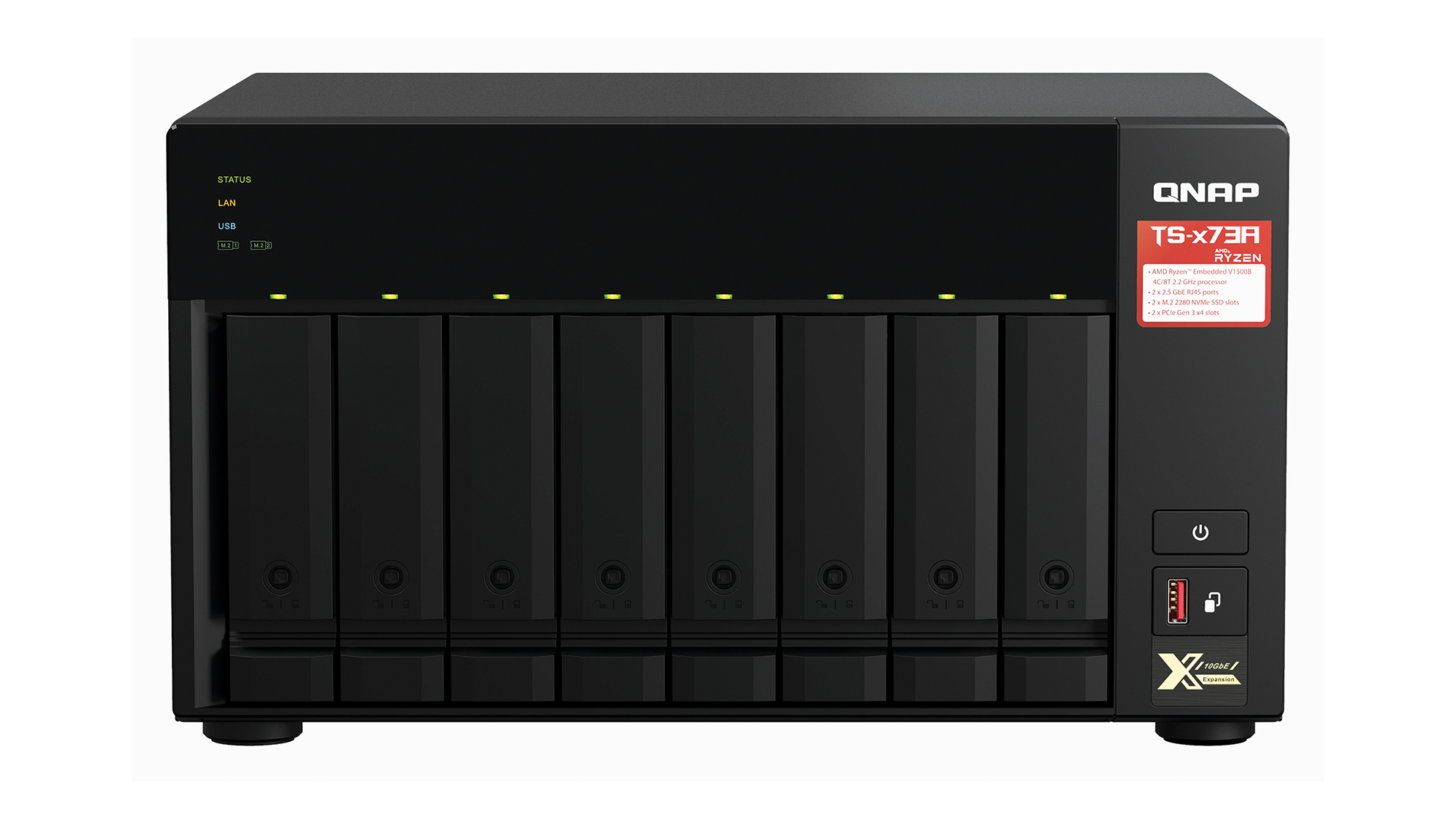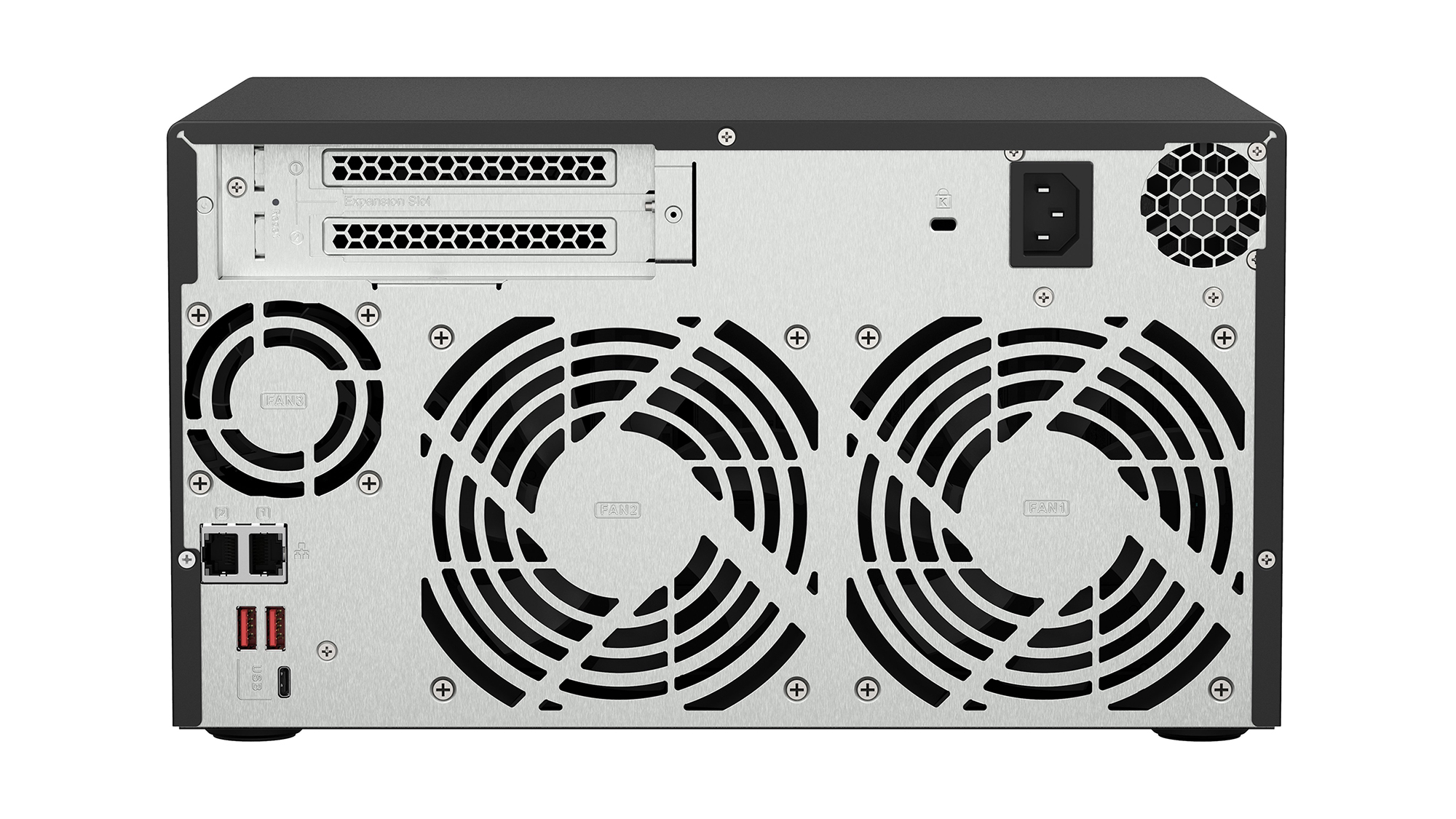Qnap TS-873A review: A supremely versatile business NAS
Great performance and a choice of operating systems make this an excellent appliance


-
+
Excellent speeds
-
+
Choice of operating systems
-
+
Wide range of software
-
+
Strong expansion potential
-
-
Some deployments require RAM upgrade

No two IT infrastructures are alike, and there’s no such thing as a ‘one size fits all’ solution. Qnap’s eight-bay TS-873A desktop appliance arguably comes close, though, with the flexibility to fit a range of business needs.
The TS-873A is all about choice: on first boot you’ll be asked whether you want to install Qnap’s standard QTS operating system or the more advanced QuTS hero platform. It’s worth thinking carefully about which you pick, as there are significant differences between the two, and if you later change your mind then the only way to switch is to back up your data and completely reinitialise the unit.
For SMBs seeking a simple storage solution, QTS is the obvious choice. It provides all of the key services you would expect from a NAS appliance, and works with every app Qnap has to offer. It will also fit happily within the base 8GB of DDR4 memory that comes preinstalled on the TS-873A.
If you want enterprise-class data security and protection features, QuTS is the way to go. It’s a 128-bit ZFS-based OS which supports copy-on-write for fast, near-unlimited snapshots, as well as end-to-end checksums for error recovery and inline deduplication and compression, which can offer big storage savings.
QuTS adds support for triple-parity arrays too, meaning your data is protected even if three drives fail at once. What’s more, WORM policies help ensure your data archives can’t be tampered with or deleted. The only catch is that QuTS is a more demanding platform: deduplication requires a minimum of 16GB of memory to function, and if you plan to use a 10GbE connection you’ll want to boost this to 32GB to avoid resource bottlenecks.

Aside from that, you don’t need to worry about horsepower – there’s a meaty quad-core 2.2GHz AMD Ryzen V1500B CPU in the driving seat, and storage options are versatile too. The eight front-facing SATA drive bays support both mechanical disks and SSDs, and are accompanied by two internal M.2 NVMe SSD slots. At the rear, dual 2.5GbE ports provide a nice performance boost over a regular Gigabit Ethernet connection, and if you need more speed than that, a pair of PCIe slots sit ready for 10GbE cards or other upgrades.
Our review unit came loaded with 32GB of RAM, so we started by installing QuTS on a pair of mirrored 960GB Micron SFF SSDs (QuTS prefers these for optimum system pool performance, whereas QTS doesn’t care). For data storage, we used three 14TB Seagate IronWolf Pro hard disks, and were up and running with a 25TB RAID5 storage pool in around five minutes.
For testing, we also slotted in a Broadcom 10GbE card, and connected to the NAS from a Dell PowerEdge T640 Xeon Scalable tower running Windows Server 2019. The results were just what you would hope to see: Iometer reported read and write speeds of 9.2Gbits/sec and 7.8Gbits/sec respectively.
Real-world performance was similarly strong. Copies of a 25GB test file between the NAS and server were completed at average read and write rates of 8.5Gbits/sec and 4.5Gbits/sec, while our backup test was dispatched at a creditable 2.5Gbits/sec. IP SAN speeds are up there too, with a 500GB target delivering read and write rates of 9.2Gbits/sec and 8.7Gbits/sec; configuring a dual 10GbE MPIO link boosted these to 12.5Gbits/sec and 10.6Gbits/sec.
We then tried the same tests under QTS. After reinitialising the appliance (which took around 20 minutes), we were pleased to find that performance was as good as with QuTS. In fact, QTS delivered slightly better write performance in our NAS and IP SAN tests, but not enough to make any significant difference.
Whichever OS you choose, Qnap’s software support is excellent, with 109 apps available for QuTS and 123 for QTS. All backup and file-syncing apps are available for download, including Hybrid Backup Sync 3, Qsync Central and HybridMount, as well as Hyper Data Protector which protects VMware and Hyper-V virtual environments.
It adds up to a very impressive and flexible desktop NAS. If you want to get the best from QuTS, you’ll need to upgrade the RAM, but both OSes deliver great performance, and those dual PCIe slots offer plenty of expansion potential.
Qnap TS-873A specifications
| Chassis | Desktop chassis |
| CPU | 2.2GHz AMD Ryzen V1500B processor |
| Memory | 8GB DDR4 RAM (max 64GB) |
| Storage | 8 x LFF hot-swap drive bays, 2 x M.2 NVMe SSD slots |
| PSU | Internal 250W PSU |
| RAID support | Supports RAID0, 1, 5, 6, 10, 50, 60, Triple Parity, Triple Mirror (with QuTS) |
| Network | 2 x 2.5GbE |
| Other ports | 3 x USB-A 3.2, USB-A 3.1 |
| Management | QTS/ QuTS hero |
| Dimensions (WDH) | 329 x 281 x 188mm |
| Warranty | 3yr hardware warranty |
Get the ITPro daily newsletter
Sign up today and you will receive a free copy of our Future Focus 2025 report - the leading guidance on AI, cybersecurity and other IT challenges as per 700+ senior executives
Dave is an IT consultant and freelance journalist specialising in hands-on reviews of computer networking products covering all market sectors from small businesses to enterprises. Founder of Binary Testing Ltd – the UK’s premier independent network testing laboratory - Dave has over 45 years of experience in the IT industry.
Dave has produced many thousands of in-depth business networking product reviews from his lab which have been reproduced globally. Writing for ITPro and its sister title, PC Pro, he covers all areas of business IT infrastructure, including servers, storage, network security, data protection, cloud, infrastructure and services.
-
 Westcon-Comstor and Vectra AI launch brace of new channel initiatives
Westcon-Comstor and Vectra AI launch brace of new channel initiativesNews Westcon-Comstor and Vectra AI have announced the launch of two new channel growth initiatives focused on the managed security service provider (MSSP) space and AWS Marketplace.
By Daniel Todd Published
-
 Third time lucky? Microsoft finally begins roll-out of controversial Recall feature
Third time lucky? Microsoft finally begins roll-out of controversial Recall featureNews The Windows Recall feature has been plagued by setbacks and backlash from security professionals
By Emma Woollacott Published
-
 The UK government wants quantum technology out of the lab and in the hands of enterprises
The UK government wants quantum technology out of the lab and in the hands of enterprisesNews The UK government has unveiled plans to invest £121 million in quantum computing projects in an effort to drive real-world applications and adoption rates.
By Emma Woollacott Published